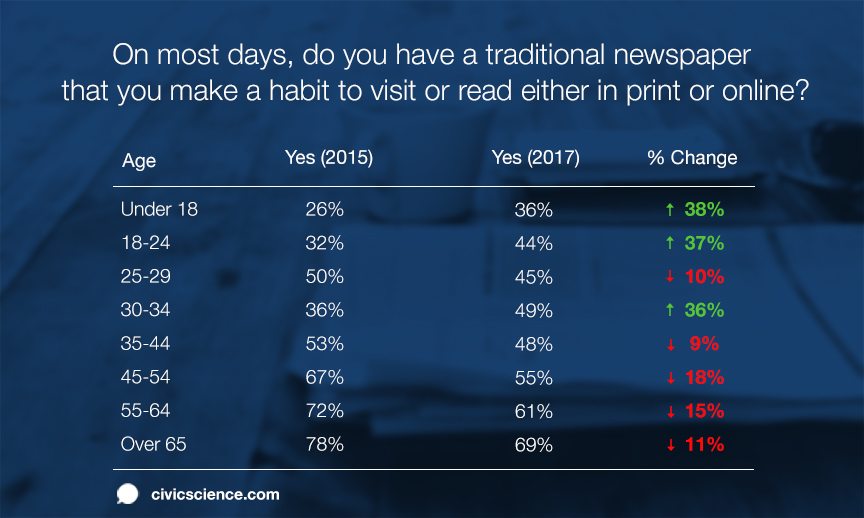The Gist: Three age groups seem to be leading the recent spike in newspaper readership: Those under 18 years old (Gen Z), those 18-24 years old, and those between 30 and 34 years old.
Volleyed by the 2016 election, traditional newspaper readership has been somewhat bolstered as of late. That doesn’t put the onward decline in readership out of sight, however, as less and less consumers are reading traditional newspapers each year.
As we all know, older folks are more likely to read traditional newspapers – that much is documented. However, there has been relatively little research on those at the younger end of the age spectrum, particularly those under 18 years old (Gen Z). We set out to see what we could find in the CivicScience database, and discovered surprising results in the process.
In 2015, we asked roughly 3,000 Americans whether they read a traditional newspaper, either in print or online, most days. Recently, we relaunched that question, and found that those who do read traditional newspapers have declined. No surprises there. However, check out the following findings regarding age:
We’ve seen a decline in newspaper readership in every age group except for three: those under 18, those 18-24, and those ages 30-34. The most significant rise, as you can see, stems from the Gen Z cohort. There is only one segment of Millennials (25-29) that are reading traditional newspapers less than the last time we asked the question.
Naturally, the incidence of readership among these younger groups is still much lower than their more mature counterparts, but if the trend continues, it may not be that way for long. This foresight is supported by a recent Pew study showing that younger Americans are preferring to read the news, while it’s the older generations that prefer to watch it.
There are a plethora of possibilities that could explain this trend, as well, from the idea that Gen Z shares more in common with older generations than even close-in-age Millennials, to the younger generation’s dislike of digital ads. Traditional newspapers’ growth in the mobile space is presumably a major factor, as well.
With all of this in mind, newspapers can continue workshopping their content for younger readers, as many have already done, But we aren’t just talking about Millennials. These sources have a captive audience among Gen Z, and it would be wise to hold them in consideration. Newspapers may even want to prioritize them, as Gen Z will account for 40% of U.S. consumers in just the next three years.









